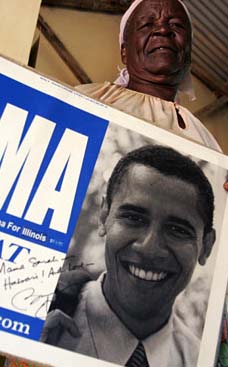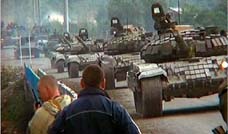2008.11.21: November 21, 2008: Headlines: COS - Colombia: Architecture: United Nations: New York Times: Michael Adlerstein to make UN green
Peace Corps Online:
Directory:
Colombia:
Special Report: Architect and Colombia RPCV Michael Adlerstein:
2008.11.21: November 21, 2008: Headlines: COS - Colombia: Architecture: United Nations: New York Times: Michael Adlerstein to make UN green
Michael Adlerstein to make UN green
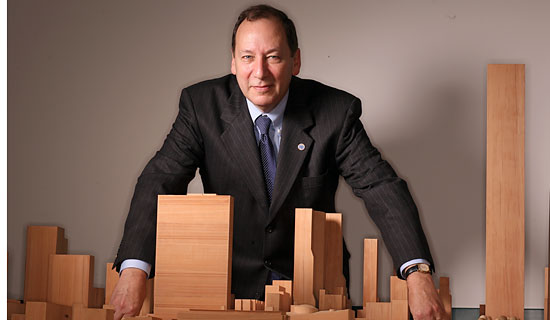
“What we are going to straighten out with this renovation are the accretions of 60 years of the building being used without the right discipline,” said Mr. Adlerstein, a Brooklyn-born architect who has previously tackled historic sites like Ellis Island and the Statue of Liberty. “We will bring out some of the details that were lost.” As he walked around the first four floors of the building, the most public spaces, he pointed out materials — brushed stainless steel, vinyl, Formica — considered magically new when the Secretariat was inaugurated in 1952. The steel elevator banks with the call-button panels featuring the United Nations logo will stay, albeit spruced up, as will the vinyl seats around the Security Council table, with their baby blue color signaling that they are for members. “There are wonderful little things that get into people’s minds that we will respect,” Mr. Adlerstein said. “It’s an old hat that everyone puts on every day. It feels right.” Other things that should not have penetrated people’s minds and bodies will be stripped out, namely asbestos. The building is infested with the stuff, used behind nearly every wall as insulation and fireproofing. “They spread it around like mayonnaise,” Mr. Adlerstein said of the original builders. Architect Michael Adlerstein served as a Peace Corps volunteer in Colombia, and is executive director of the $1.9 billion United Nations renovation project.
Michael Adlerstein to make UN green
Renovating the U.N., With Hints of Green
By NEIL MACFARQUHAR
Published: November 21, 2008
Caption: Michael Adlerstein, architect of the UN renovation, said, "It will be done right." Photo: Fred R. Conrad/NYT
UNITED NATIONS — Michael Adlerstein, the man leading the complex project to restore the United Nations headquarters, stood in the visitors’ lobby recently explaining why it is considered one of the building’s signature rooms
Those unadorned gold columns along the front entrance? A stark design that was considered outrageously simple when it was unveiled around 1950, along with the streamlined concrete balconies and industrial bridge supporting the wide staircase. The columns faintly echo parliament buildings all over the world, which in turn hark back to classical temples.
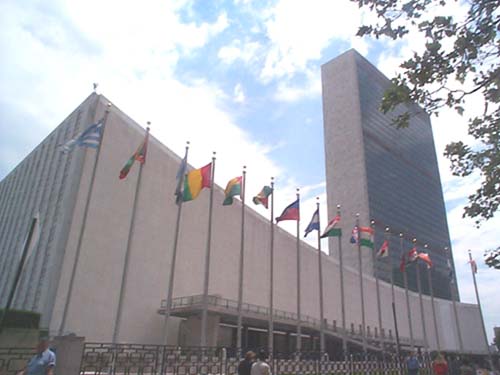
Adlerstein is unfazed by the problems that have beset past plans. "I took the job because it's an ideal challenge for an architect at this point in my career," he said. "It's an iconic building of great stature in the world, you can show a picture of this building to people in remote, rural locations in the world and everyone will know it." While the famous exteriors will be unchanged, the insides will be brought up to 21st-century standards of efficiency and security and reconfigured to consume 40 percent less energy. The greenish glass curtain wall will be removed and replaced by a heavily laminated one that appears identical but is far stronger and will be able to withstand the blast in the event of a bomb attack on the building. Energy saving additions include sensors that turn off lights in unoccupied rooms and solar power systems. "Ten years from now there will be no way to tell that the UN was renovated unless you look at the Con Ed bill," Adlerstein said. Architect Michael Adlerstein served as a Peace Corps volunteer in Colombia, and is executive director of the $1.9 billion United Nations renovation project.
The visible air-conditioning ducts at neck-craning distance overhead, the blue paint peeling and drifting like snowflakes to the lobby floor? Their exposure is also a Modern touch that has since become commonplace.
That long brown abstract rendering that dominates one 50-foot stretch of white wall? Not another piece of bad art foisted on the organization by one of its member states, something of a hallowed United Nations tradition, but an unsightly water stain from a leak.
Beginning early next year, all 5,000 people working in the United Nations Secretariat will start shifting to scattered temporary offices, mostly in Midtown, while the headquarters in the Turtle Bay neighborhood of Manhattan undergoes a five-year, nearly $2 billion renovation. After it is emptied, the building, one of the most visited in New York City, will be gutted.
Planning for the reconstruction included deciding which parts of the 39-story building’s art and architecture were worth preserving, the benchmark being what the world identifies with the United Nations. The basic plan is to strip the building down to the pure, flat surfaces that made it innovative when it opened, while replacing the outdated innards like air-conditioning, lighting, wiring and plumbing.
“What we are going to straighten out with this renovation are the accretions of 60 years of the building being used without the right discipline,” said Mr. Adlerstein, a Brooklyn-born architect who has previously tackled historic sites like Ellis Island and the Statue of Liberty. “We will bring out some of the details that were lost.”
As he walked around the first four floors of the building, the most public spaces, he pointed out materials — brushed stainless steel, vinyl, Formica — considered magically new when the Secretariat was inaugurated in 1952.
The steel elevator banks with the call-button panels featuring the United Nations logo will stay, albeit spruced up, as will the vinyl seats around the Security Council table, with their baby blue color signaling that they are for members.
“There are wonderful little things that get into people’s minds that we will respect,” Mr. Adlerstein said. “It’s an old hat that everyone puts on every day. It feels right.”
Other things that should not have penetrated people’s minds and bodies will be stripped out, namely asbestos. The building is infested with the stuff, used behind nearly every wall as insulation and fireproofing. “They spread it around like mayonnaise,” Mr. Adlerstein said of the original builders.
Another goal of the renovation is to make the building far more green, reducing its energy consumption by 44 percent. For example, the famous outer wall, a glass curtain, was considered wildly modern for its time, with all the superstructure hidden behind it. Now, even with the windows firmly shut, the interior curtains flutter in the breeze from the East River.
The new glass will not only be more efficient — interspersed with photovoltaic cells that will turn sunlight into energy — but also more secure. The windows will no longer open. An impermeable wall of the latest glass can bend as much as 10 inches in the face of a large explosion — a feature considered a must in an era when some United Nations offices around the world have been targets of suicide bombers.
Basically there are three different levels of renovation. The first includes those character-defining elements of the building that will not change physically at all, like the General Assembly and the Security Council chamber. But they will get better, energy-efficient lighting and an air-conditioning system that will pump air out of the floor instead of the ceiling, again making the space more efficient and cheaper.
Then there are design elements that will stay, like the curved interior walls designed by Oscar Niemeyer of Brazil, which echo his trademark glazed-exterior wall of the General Assembly facing First Avenue. (Legend has it that he also wanted a simple curved roof, but the Vermont senator serving as the first chief of the United States Mission said that Congress would approve the budget much faster if he put a dome on it so American legislators could easily recognize it as an assembly hall.)
The most radical renovations will take place in the upper stories, which the public never sees. Most of the office walls will be ripped out and the floors re-created using an open pod system, which will be much easier to reconfigure, given the constant shifting of employees. The various buildings on the campus will be tackled in stages.
Wallace Harrison, the architect for the Rockefellers, did much of the final design, based on concepts envisioned by an international dream team of architects, including Le Corbusier and Mr. Niemeyer. Le Corbusier conceived what many architects consider the building’s best-known element: the thin slab towering over the river, all the more striking than most New York skyscrapers because it stood so alone.
“It is really a monument,” said Jean-Louis Cohen, a French architect who teaches architectural history at New York University’s Institute of Fine Arts. Not that it didn’t have detractors. Writing in The New Yorker, the critic Lewis Mumford called it “a climax of formal purity and functional inadequacy.”
The organization has always struggled with a lack of space. The complex was designed to accommodate 75 member states and 700 conferences each year, but it has grown to 192 members and stages some 8,000 meetings annually.
Aside from the physical building, the restoration project also involves the art, much of which will be used to spruce up the prefabricated three-story structure rising on the north lawn that will house the secretary general and his staff. Because tourists will not be allowed into the main building during reconstruction, the art is supposed to serve as the substitute attraction.
Some donations are considered eyesores, some minor embarrassments — like the priapic sculpture of a bull elephant near the north fence, his majestic anatomy safely hidden by a thick hedge the height of his stomach. There has been a moratorium on new gifts during the renovation.
Large items affixed to the walls of the Secretariat will be encased in their own structures with heating and air-conditioning while the rest of the interior is exposed to the elements. These include a third-century mosaic floor from Tunisia and two large murals by the Cubist artist Fernand Léger, who was eventually barred from the United States for his association with the Communist Party. President Truman, on first spotting the murals, is said to have commented that one looked like a bunny coming out of a hat, and another a fried egg.
Like many United Nations projects, the renovation has been dogged by escalating costs and whiffs of scandal over some contractors. The estimated price tag has risen to $1.9 billion, from $1.1 billion, as the project has faced repeated delays since being approved in 2002. Member countries are being assessed a fee that matches the percentage of their annual contribution to the operating budget.
The renovation can only bring so much change. Knowing that members have been haggling over expanding the Security Council beyond its 5 permanent and 10 rotating members, Mr. Adlerstein wondered if he should perhaps create a bigger table with more seats.
The idea was rejected — architecture will not drive policy, officials said. He added that he was told that the room would just have to be renovated again if the members ever reach an agreement.
Links to Related Topics (Tags):
Headlines: November, 2008; RPCV Michael Adlerstein (Colombia); Peace Corps Colombia; Directory of Colombia RPCVs; Messages and Announcements for Colombia RPCVs; Architecture; United Nations
When this story was posted in December 2008, this was on the front page of PCOL:
Peace Corps Online The Independent News Forum serving Returned Peace Corps Volunteers 








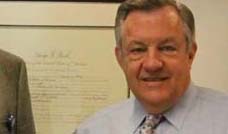 | Director Ron Tschetter: The PCOL Interview
Peace Corps Director Ron Tschetter sat down for an in-depth interview to discuss the evacuation from Bolivia, political appointees at Peace Corps headquarters, the five year rule, the Peace Corps Foundation, the internet and the Peace Corps, how the transition is going, and what the prospects are for doubling the size of the Peace Corps by 2011. Read the interview and you are sure to learn something new about the Peace Corps. PCOL previously did an interview with Director Gaddi Vasquez. |
Read the stories and leave your comments.

Some postings on Peace Corps Online are provided to the individual members of this group without permission of the copyright owner for the non-profit purposes of criticism, comment, education, scholarship, and research under the "Fair Use" provisions of U.S. Government copyright laws and they may not be distributed further without permission of the copyright owner. Peace Corps Online does not vouch for the accuracy of the content of the postings, which is the sole responsibility of the copyright holder.
Story Source: New York Times
This story has been posted in the following forums: : Headlines; Adlerstein; COS - Colombia; Architecture; United Nations
PCOL42566
70












